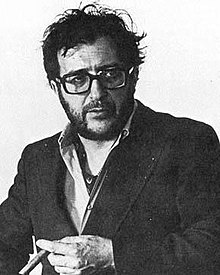
Louis Joseph Andriessen was a Dutch composer, pianist and academic teacher. Considered the most influential Dutch composer of his generation, he was a central proponent of The Hague school of composition. Although his music was initially dominated by neoclassicism and serialism, his style gradually shifted to a synthesis of American minimalism, big band jazz and the expressionism of Igor Stravinsky.

Pascal Georges Dusapin is a French composer. His music is marked by its microtonality, tension, and energy.

The Swingles are an a cappella vocal group. The Swingle Singers were originally formed in 1962 in Paris under the leadership of Ward Swingle. In 1973, Swingle disbanded the French group, and formed an English group known initially as Swingle II and later as the New Swingle Singers, before settling on the Swingles name.

A pit orchestra is a type of orchestra that accompanies performers in musicals, operas, ballets, and other shows involving music. The term was also used for orchestras accompanying silent movies when more than a piano was used. In performances of operas and ballets, the pit orchestra is typically similar in size to a symphony orchestra, though it may contain smaller string and brass sections, depending upon the piece. Such orchestras may vary in size from approximately 30 musicians to as many as 90–100 musicians. However, because of financial, spatial, and volume concerns, current musical theatre pit orchestras are considerably smaller.
The alto clarinet is a woodwind instrument of the clarinet family. It is a transposing instrument pitched in the key of E♭, though instruments in F have been made. In size it lies between the soprano clarinet and the bass clarinet. It bears a greater resemblance to the bass clarinet in that it typically has a straight body, but a curved neck and bell made of metal. All-metal alto clarinets also exist. In appearance it strongly resembles the basset horn, but usually differs in three respects: it is pitched a whole step lower, it lacks an extended lower range, and it has a wider bore than many basset horns.
A multiphonic is an extended technique on a monophonic musical instrument in which several notes are produced at once. This includes wind, reed, and brass instruments, as well as the human voice. Multiphonic-like sounds on string instruments, both bowed and hammered, have also been called multiphonics, for lack of better terminology and scarcity of research.
Sequenza is the name borne by fourteen compositions for solo instruments or voice by Luciano Berio. The pieces, some of which call for extended techniques, are:

Folk Songs is a song cycle by the Italian composer Luciano Berio composed in 1964. It consists of arrangements of folk music from various countries and other songs, forming "a tribute to the extraordinary artistry" of the American singer Cathy Berberian, a specialist in Berio's music. It is scored for voice, flute, clarinet, harp, viola, cello, and percussion. The composer arranged it for a large orchestra in 1973.
Henri Léon Marie-Thérèse Pousseur was a Belgian classical composer, teacher, and music theorist.
Bernard Rands is a British-American contemporary classical composer. He studied music and English literature at the University of Wales, Bangor, and composition with Pierre Boulez and Bruno Maderna in Darmstadt, Germany, and with Luigi Dallapiccola and Luciano Berio in Milan, Italy. He held residencies at Princeton University, the University of Illinois, and the University of York before emigrating to the United States in 1975; he became a U.S. citizen in 1983. In 1984, Rands's Canti del Sole, premiered by Paul Sperry, Zubin Mehta, and the New York Philharmonic, won the Pulitzer Prize for Music. He has since taught at the University of California, San Diego, the Juilliard School, Yale University, and Boston University. From 1988 to 2005 he taught at Harvard University, where he is Walter Bigelow Rosen Professor of Music Emeritus.

Vinko Globokar is a French-Slovenian avant-garde composer and trombonist.
André Laporte is a Belgian composer.

Sinfonia (Symphony) is a composition by the Italian composer Luciano Berio which was commissioned by the New York Philharmonic for its 125th anniversary. Composed in 1968–69 for orchestra and eight amplified voices, it incorporates musical quotations to represent an abstract and distorted history of culture. The eight voices are not incorporated classically but rather speak, whisper and shout excerpts from texts including Claude Lévi-Strauss' The Raw and the Cooked, Samuel Beckett's novel The Unnamable, instructions from the scores of Gustav Mahler and other writings.
Zygmunt Krauze is a Polish composer of contemporary classical music, educator, and pianist.
Stojan Stojkov is a Macedonian composer and pedagogue. He completed his education on music at Belgrade Music Academy, where he graduated on the Department of Composition. Stojkov is author of numerous works of almost all genres and forms of music. His creative opus includes symphonies, vocal-instrumental, vocal, and staged works, chamber compositions, works for children and other kinds of music creative works.

Laborintus II is an album by the Belgian orchestra Ictus Ensemble, the vocal group Nederlands Kamerkoor, and the American vocalist Mike Patton, which was recorded live at the 2010 Holland Festival. It was released on July 10, 2012, by Ipecac Recordings, and debuted at number 23 on the American Billboard Classical Albums Chart. It was not well received by critics.

Luca Francesconi is an Italian composer. He studied at the Milan Conservatory, later with Karlheinz Stockhausen and then Luciano Berio.

Luciano Berio was an Italian composer noted for his experimental work, and for his pioneering work in electronic music. His early work was influenced by Igor Stravinsky and experiments with serial and electronic techniques, while his later works explore indeterminacy and the use of spoken texts as the basic material for composition.

Cries of London is a composition for eight voices by Italian composer Luciano Berio. Originally composed for six voices in 1974, it was expanded in 1976.








